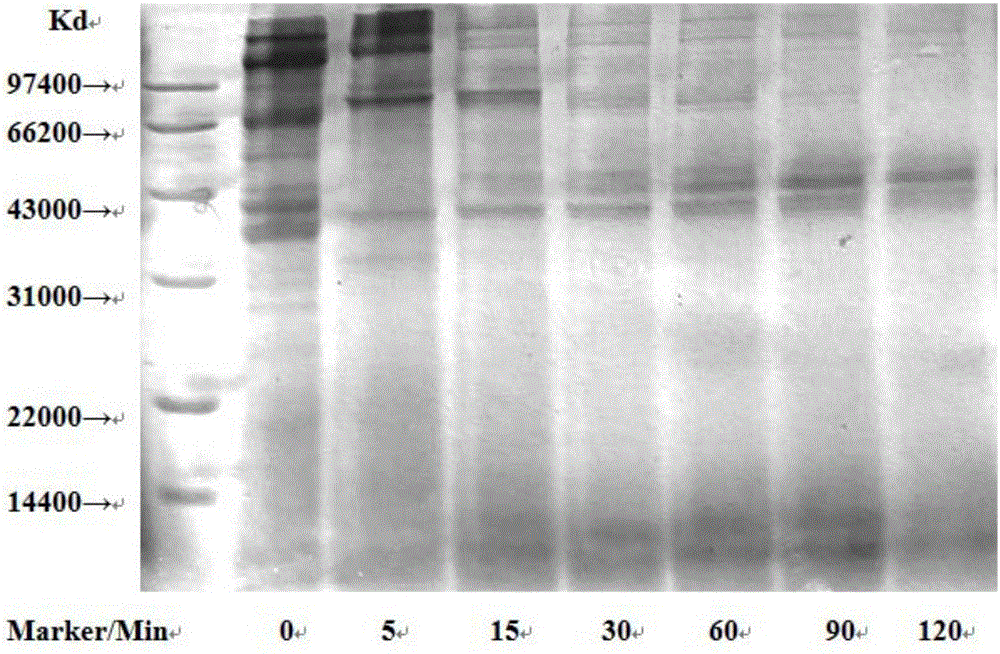Method for screening potential allergens in food
A screening method and allergen technology, applied in the field of inspection and quarantine, can solve the problems of limited accuracy and application, incomplete and reliable conclusions, large workload, etc., achieving easy high-throughput screening, simple and easy method, and repeatability strong effect
- Summary
- Abstract
- Description
- Claims
- Application Information
AI Technical Summary
Problems solved by technology
Method used
Image
Examples
Embodiment 1
[0030] 1. Extraction of protein from large yellow croaker
[0031] Take 300g of washed large yellow croaker muscle, grind the large yellow croaker muscle with a blender, then homogenize the ground fish meat with a homogenizer, add 7 times the volume of water, and adjust the pH value to about 2.4 with hydrochloric acid , to dissolve most of the protein, centrifuge at 5000r / min for 15min, and collect the supernatant. Then adjust the pH value of the supernatant to about 4.75 with sodium hydroxide solution to precipitate the protein, centrifuge at 5000r / min for 15min, collect the protein precipitate, and freeze-dry it for future use.
[0032] 2. In vitro simulated gastric juice digestion
[0033] Simulated gastric juice: Weigh 0.1g NaCl in 50ml distilled water, adjust the pH to 1.2 with HCl, add pepsin to make the mass concentration of pepsin 150ug / ml.
[0034] The control solution was prepared in the same way, and the difference from the simulated gastric juice was that it only...
Embodiment 2
[0049] Using a method similar to that of Example 1, Spanish mackerel protein was extracted and digested. After digestion with simulated gastric juice, two enzyme-resistant protein bands were found, with molecular weights around 35kDa and 45kDa, as shown in the attached figure 2 shown.
[0050] The enzymolysis-resistant protein bands of Spanish mackerel were hydrolyzed in gel, analyzed by liquid chromatography-mass spectrometry, and identified in combination with the protein database. The results are shown in Table 2:
[0051] Table 2: General-purpose liquid chromatography-mass spectrometry identification results of enzymatic hydrolysis-resistant bands of Spanish mackerel proteins
[0052]
[0053] The NCBI / blast database was used to compare the identified Spanish mackerel protein with known allergen or epitope sequences, and the following results were obtained:
[0054] 1. The homology of enolase in Spanish mackerel and known allergen enolase in Wuchang fish (Megalobram...
Embodiment 3
[0057] Using the method of Example 1, the allergens of egg white protein were screened.
[0058] The results of SDS-PAGE electrophoresis analysis of digestion products under different digestion time conditions are shown in the attached image 3 shown.
[0059] Table 3 shows the identification and analysis results of the peptides obtained by enzymolysis-resistant bands by liquid chromatography-mass spectrometry after in-gel enzymolysis.
[0060] Table 3. General-purpose liquid chromatography-mass spectrometry identification results of enzymatic hydrolysis-resistant bands of egg white proteins
[0061]
[0062] The enzyme-resistant protein in egg white was identified as ovalbumin, which is the main allergen reported in eggs. In summary, the enzymolysis-resistant proteins obtained by in vitro digestion with simulated gastric juice are highly allergic, so this method is feasible.
PUM
| Property | Measurement | Unit |
|---|---|---|
| Molecular weight | aaaaa | aaaaa |
| Molecular weight | aaaaa | aaaaa |
Abstract
Description
Claims
Application Information
 Login to View More
Login to View More - R&D
- Intellectual Property
- Life Sciences
- Materials
- Tech Scout
- Unparalleled Data Quality
- Higher Quality Content
- 60% Fewer Hallucinations
Browse by: Latest US Patents, China's latest patents, Technical Efficacy Thesaurus, Application Domain, Technology Topic, Popular Technical Reports.
© 2025 PatSnap. All rights reserved.Legal|Privacy policy|Modern Slavery Act Transparency Statement|Sitemap|About US| Contact US: help@patsnap.com



